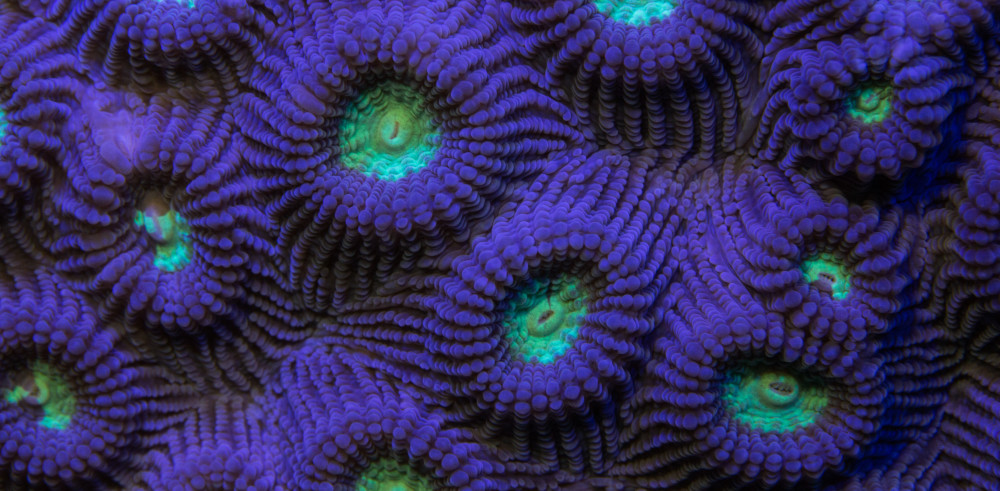The crown of thorns starfish (Ancanthaster planci) plays an important role in the underwater world. They generally feed on the fastest growing corals, allowing the slower growing coral to establish ground. They are the coral moderators, the gardeners of the sea and help increase the diversity of coral species on the reef.

Mature Crown of thorns starfish © Shawn Miller
Animals that feed on coral are known as corallivores.

Natural coral bleaching © Shawn Miller
In Okinawa, we have a variety of Corallivorous marine snails ( Drupella sp). These small snails have also caused serious damage to coral reefs.

Corallivorous snails © Shawn Miller
The venomous sea star has sharply pointed spines that deliver a painful sting. The spines inject venom which causes extreme pain, discomfort and nausea. Most injuries occur because recreation Scuba divers cut up the starfish with a dive knife and the spine penetrates the hand. The starfish serves a purpose in the ecosystem so leave it alone. They are a native marine animal of the Ryukyu Islands.

COTS of Okinawa © Shawn Miller

COTS venomous spines © Shawn Miller
In Okinawa, we have had massive COTS outbreaks in the past. These outbreaks have devastated some of the most beautiful shallow water coral reefs.

Juvenile COTS feeding © Shawn Miller
Possible Outbreak Causes
- A natural cycle of nature
- The decrease in natural predators that feed on COTS
- Increase in food source caused by agricultural runoff, causing a blooming effect.
Coral crabs are one of the natural protectors of the coral reef. The coral provides shelter and food for the coral crabs. The crabs are on call to defend against the coral-eating starfish and other marine predators.

Coral crabs (Calcinus minutus) © Shawn Miller

Coral crabs (Cymo melanodactylus) © Shawn Miller

Protective Coral crab (Trapezia sepata) © Shawn Miller

Coral hermit crab (Pagurita vittata) © Shawn Miller

Gall coral crabs © Shawn Miller
COTS have many natural predators. Over the last twenty-five years, I have observed marine snails, harlequin shrimp, sea anemones and fish feeding on healthy and injured COTS in the wild. I was not able to get photographs of all of this behavior taking place, many natural observations occurred before I purchased an underwater camera.

Marine snails feeding on COTS © Shawn Miller
The trident trumpet (Charonia tritonis) is sought after by fisherman and shell collectors worldwide. The meat is a popular food source and the beautiful shell is valuable.

These large snails are capable of eating mature COTS. Overtaking has reduced populations of this of this predatory snail. More effort needs to be directed to the protection of this species. I have personally observed populations drastically decline over the years.

Trident trumpet © Shawn Miller

Trident trumpet feeding © Shawn Miller
The Harlequin shrimp feed on juvenile COTS in the wild and captivity. Harlequin shrimp populations are decreasing as well due to the over-collecting for the pet trade market.

Harlequin shrimp feeding © Shawn Miller
Sea anemones are vicious predators and known to feed on the crown of thorns as well.

Sea anemone © Shawn Miller
Red soil runoff contributes to coral reef bleaching and fertilizers entering the water. Could fertilizers, sewage or pollution really be the cause for a massive bloom in plankton causing an outbreak of healthy numbers of baby COTS?

Okinawa agricultural runoff © Shawn Miller
My Mission: To Document and Preserve the Wildlife of the Ryukyu Islands
This site is also designed to help people identify the beautiful animals of Okinawa, basically to serve as an online nature reference guide. If you would like to make a contribution to support my mission, please click on the donation link paypal.me/maketheswitch4nature
Your donations will help conservation initiatives as well as bring solutions to the worldwide pollution issues on our beautiful shorelines. Thank you for your support, Shawn M Miller.
#MakeTheSwitch4Nature
 The Common Kingfisher spends most of the day patiently waiting on tree branches above the water.
The Common Kingfisher spends most of the day patiently waiting on tree branches above the water. They watch from above and pick out the perfect sized fish.
They watch from above and pick out the perfect sized fish. After the feast, the Kingfisher preens itself.
After the feast, the Kingfisher preens itself.
 I challenge you to get outdoors for some Nature Therapy.
I challenge you to get outdoors for some Nature Therapy.

































































































